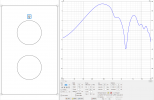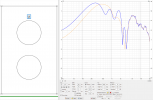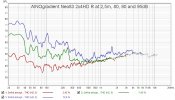Thanks a lot, Ctrl!Since I always find such questions exciting, I have simulated it for you - but only with simple means via VCAD (which is sufficiently accurate) and not via a BEM-LEM simulation.
1. Sketch of the baffle and determine baffle diffraction (BD)
I made a rough sketch of the baffle and exported the OB baffle diffraction frequency response.
View attachment 237133
2. Enclosure simulation, import BD, target curve
Next, the Enclosure tool was used to simulate the behavior of the woofer. The BD FR was imported and adjusted to match our target curve with HP-LR4@120Hz.
The target curve in orange, the frequency response of the driver in the baffle in brown and the driver in the infinite baffle in black.
View attachment 237135
With this, we have finished creating our target frequency response for the woofer of the LX521 in the open baffle with HP-LR4@120Hz XO.
3. Evaluation of the driver excursion
So now we can take a look at the driver excursion at 90dB@1m, 100dB@1m and 105dB@1m in the free field.
Since VCAD's tool always refers to the half-space, we must simulate this in the tool with 96dB (brown curve) for 90dB free field (for 100,105dB accordingly).
View attachment 237136 View attachment 237137 View attachment 237138
The Seas woofer U22REX has two distortion peaks - at 100Hz (3% HD2@90dB-2pi) and 700Hz (2% HD2@90dB-2pi)***. However, both consist mainly of HD2, so should hardly be audible directly due to masking, but could still provide some increased IMD with multitone excitation.
Because of the 100Hz distortion peak, the woofer should, for best results, in no case be crossed lower than 120Hz.
At 100dB@1m the woofer comes to its limits (the distortion should already be very high). At the latest at 105dB@1m is the end, because the woofer with over 8mm excursion comes dangerously close to the maximum 10mm voice coil excursion - so that there is a danger that the voice coil hits the back plate of the motor system, which is not a pleasant noise.
***Source: Hobby HiFi 2013-4
Looks a bit better than I thought.
With that (new information for me) in mind, how is it relative to the sub section? I mean the 8" at 120 Hz relative to the subs at let say 35 - 40 Hz, excursion wize?
I'm asking cause I already bought these sub drivers, but have a chance of buying a second hand complete set of these speakers. So if needed/reasonable, I could double up on the subs. In that case I have to put them together horisontally and use them as a TV table.












